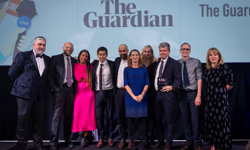
A bad workman blames his tools. Or so the saying goes. Rich Cheary begs to differ, certainly when it comes to publishing. “Expecting journalists to serve up brilliant, immersive and timely content, but giving them inadequate tools, is asking the impossible.”
I met with Rich for a couple of hours in early June in the genteel surroundings of the Cooden Beach Hotel in Bexhill-on-Sea and I was impressed that he managed to sit still throughout! I mention this only because I’d heard that he was a tad energetic, a man whose idea of relaxation is trail running up and down mountains, who, together with CTO Clinton Bosch, takes every opportunity when travelling on business to dash up the nearest peak, to hunt a ridge-line or single tracks to burn down. Each to their own…
We were meeting, not to discuss his predilection for extreme sports, but to look at the challenges publishers face and how the Publisher’s Toolbox can help them be more creative, productive and profitable.
“Publishers need powerful, simple and easy-to-use tools to compete effectively”, says Rich. The Publisher’s Toolbox is a suite of digital products that includes an Amazon cloud hosted digital publishing platform (Baobab Suite), a secure mobile journalist app platform to file stories on the move (MoJoReporter), a tool to help publishers easily create augmented reality experiences (Augmenta), a powerful digital asset management platform (BiblioDAM), a configurable multimedia mobile app framework (MobileAppSuite), enterprise WordPress plugin set and Progressive Web App framework (Websuite), as well as an advanced Amazon image analytics and video streaming API service layer (Imigino). All these tools have been developed to meet specific publishing needs; they can run in tandem with each other or independently and can integrate with third party systems.
The tools have been developed over the last eight years, yet refined and turned into products over the past three years by parent company Afrozaar. Afrozaar was set up in 2011 by Rich and a team of Cape Town-based programmers to develop digital products for the publishing industry, with a focus on mobile apps and cloud architecture. An early client was Media24 and the UK’s Telegraph Media Group, with whom they built and deployed iPad, Kindle Fire, Android and Win8 tablet apps, which were the early beginnings of their Baobab Suite and MobileAppSuite products.
An opportunity arose to align their product suite strategy with the Independent Newspaper Media group, one of Africa’s largest newspaper and magazine publishers. INM commissioned him and his team to lead their digital transition and shift towards cloud architecture. In effect, they took the lead on defining a digital-first editorial approach and providing their digital tools and solutions across 32 print titles. The result was the complete digital transformation of a traditional print business into a digital powerhouse that can take stock of its audience, digital assets, analytics and scale new digital titles or campaigns in a cost effective and risk-free manner, says Rich. The mutual benefit is that Afrozaar now has a suite of tried and tested solutions developed hand in glove with a major publisher. The time is now right, feels Rich, to tell the world about the Publisher’s Toolbox.
The team created the Publisher’s Toolbox brand and opened a UK office, which has signed up some impressive clients including Kent Messenger Group and News UK.
The Publisher’s Toolbox is fully scalable and, Rich is keen to emphasise, is equally suitable for large publishing groups and single-title publishers, whether in the news, magazine or brand media sectors.
These are challenging and exciting times for publishers. What, I ask Rich, should publishers be doing to ensure a successful future? Rich had eight suggestions:
1. Set your journalists free
“The arrival of the smartphone gave mobile journalists the ability to file stories on the go; no longer did they have to wait to get back to the office. In theory, they could now publish the story from anywhere, yet the fact is that they are not yet truly free; they still labour under many constraints, which reduce productivity and motivation. Typically, they use a range of tools to submit their stories – FTP, email, WhatsApp, WeTransfer, DropBox etc, all of which can (kind of) do the job, but weren’t designed specifically for publishers. We believe our MoJoReporter platform improves standardisation, collaboration, communication between journos and the centralisation of their digital media for future reuse.”
2. Build your own community on your own platform
“Social media doesn’t have the monopoly on ‘community’. Publishers should look to create their own communities on their own platforms, rather than ceding control to third parties. Publishers, in collaboration with sponsors, can own the reader relationship and there are numerous imaginative ways of getting readers to interact with you, to contribute and share multimedia experiences with you rather than on social media. Incentivisation and motivation for this shift is not easy, but will pay off in the long run. Augmented Reality (AR+) and User Generated Content (UGC) are some of the areas we are exploring to provide enriched digital experiences and improved engagement with consumers of your brand and content. Both these are modules within our MobileAppSuite.”
3. Give your print edition an enhanced digital dimension
“Our approach with the Publisher’s Toolbox has always been digital-first, but not necessarily digital-only. In many sectors, print has a long and healthy future, but there’s no doubt it can be enhanced through digital innovation. One way is via augmented reality (AR+), where a reader uses a smartphone app to scan an image (not a symbol or a QR code) on the printed page to trigger additional information – which might be a simple static landing page, but which can just as easily include rich multimedia. Our Augmenta tool enables publishers to set up augmented activations cost effectively, quickly and simply, enhancing the experience for both readers and advertisers, who are presented with exciting new ways of adding value to their print advertising campaigns.”
4. Breathe new life into your archives
“Publishers’ archives represent a potential treasure trove of content – valuable text, pictures and video, in many cases stretching back decades – but for many, it’s completely unusable because it’s not retrievable. The answer is to pull it all into one central location and to properly index it. Once accessible via API services, then the opportunities are endless: put it behind a paywall or registration barrier, use it to create special supplements or a new picture library service. By making it available to your journalists, you also help them write more compelling stories, by enabling them to pull in previously published material. Once archives are indexed, and a solid foundation to access such content is in place, the possibility of personalisation and recommendations is achievable across your reader profiles. Our BiblioDAM product gives publishers a powerful tool for prising open those dusty archives.”
5. Be the best storytellers
“There will always be a place for the straight one-dimensional text-plus-picture story, but, increasingly, content is being presented in new and novel ways. People want to be immersed in the content, to experience the story in a multi-faceted way. Multimedia storyboarding is proving popular, where the reader / viewer is effectively being invited into the story, to experience the event in the round. Traditional publishers, perhaps with a one-dimensional print heritage, need to embrace these new three-dimensional story telling techniques. It’s not difficult to do. Give your reporters our MoJoReporter app to capture the sight and sound.”
6. Keep it simple
“The best workflow tools all have one thing in common – simplicity. They are easy to use and involve the minimum number of steps to get a job done, whilst in the background, they do the heavy lifting of digital asset management and reporting. If the tools you are using are inefficient, counter-intuitive or only get half the job done, then productivity and creativity will fall as your team uses them ineffectively, or starts to use poorly thought-through workaround solutions. A publisher can tell if their approach needs an overhaul by doing a ‘steps audit’. Take a commonly performed task and count the number of steps involved. The higher the number, the more inefficient the process.”
7. Be transaction-led
“As print revenues continue to decline, publishers need to increase their digital revenues. Getting people to visit your website or app is only half the battle; the other half is defining what you want them to do when they get there. How do you want them to behave? What does a profitable reader journey look like? I would suggest looking to maximise the number of visits that end with a clear transaction; be that an e-commerce purchase, a registration / subscription, a response to an advertiser message or the posting of content. Define what you want them to do, work out how you get them to do it, and then monitor performance with easily reportable KPIs.”
8. Work closer with your digital providers
“We like to see ourselves more as partners than suppliers and we offer an innovative revenue share option as an alternative to standard license fees. Content producers, platform providers and advertisers need to find ways to collaborate around a common audience. Risk and insight can be shared. We are all trying to find answers, where the ability to experiment in a cost-effective and controlled way can take you a long way. Our software is built on open standards, which means that publishers are not locked-in. We believe in sharing best practice and working together with publishers and other tech providers to create the best possible tools for publishers.”
So, I ask Rich, what’s the next step? The UK market is their primary focus and they are in discussions with a number of brands and publishers. “We are fortunate to have the experience and tools that can digitally transform traditional media groups at an enterprise level, through replatforming, change control and process implementation. At the same time, we’ve also launched new pure-digital publishing services that utilise our tools.”
Why should UK publishers get in touch, I ask. “Well,” says Rich, “if they have a set of tools that they’re 100% happy with and believe their current providers are doing the necessary R&D to lead the way digitally, then they shouldn’t! But if there are doubts, potential cost unknowns, delivery frustrations, operational inefficiencies – then we can probably help.”
As we leave the hotel, Rich dashes ahead, a meeting to get to apparently, although I have a sneaking suspicion that he’s off looking for a mountain to climb. This being Sussex, he might have to make do with the South Downs.
Richard Cheary, CEO
Email: richard.cheary@publisherstoolbox.co.uk
Richard Waghorn, Global Digital Partnership Manager
Publisher's Toolbox, 201 Borough High Street, London, SE1 1JA
Tel: 020 7193 9711










